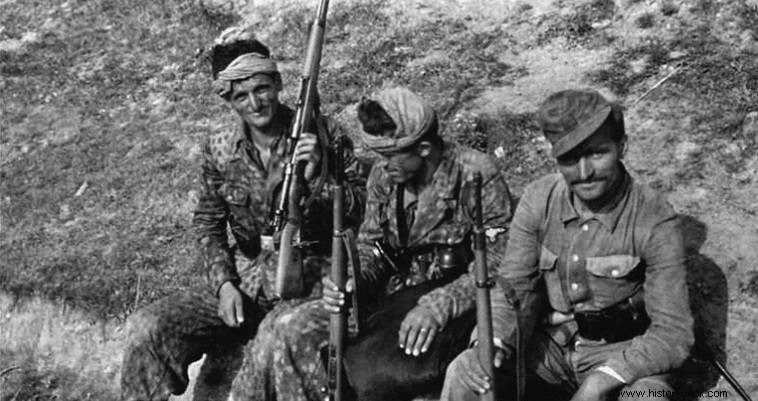
In all the conquered areas, the Germans formed armed divisions and units mainly to fight the partisans. One of the worst was the 1st Albanian Division. Albania was occupied by the Italians in April 1939. After the occupation of Greece and Yugoslavia, Italian Albania expanded territorially to include even Kosovo, realizing the Albanian nationalists' dream of a "Greater Albania". .
The Albanians, under the protection of the Italians, began the massacres of Greeks, Serbs and Montenegrins. Gradually in Kosovo, especially, soon the Serbian population was either driven out or died. After the Italian capitulation, in 1943, the Germans took under their protection the Albanians who collaborated with the Italians and especially Bali Kompetar, the Albanian "militia" responsible for thousands of deaths.
SS Division
The Germans drafted a number of Albanians into the 13th Waffen SS Mountain Division "Handschar". In this division, mostly Bosnian Muslims served. The approximately 1,000 Albanians who served in it formed the 1st battalion of the 2nd Regiment, which was later renamed the 28th Regiment. A little later another 500 Albanians joined the ranks of the division. Following this the Germans decided to form an entirely Albanian division.
The Albanian Division of the SS began to be formed in April 1944 with the prospect of serving, exclusively, in Kosovo, at the request of the political leader of the Albanian nationalists, Bedri Pejani. The Division received the official title 21st Waffen SS Division "Skanderbeg".
Although several volunteers presented themselves only 6,000 of them were deemed suitable. Thus, the Albanian "Handschar" battalion joined the newly formed division. On 1 May the Division was officially established and joined the XXI Mountain Army Corps. The officers and most non-commissioned officers were German. SS Brigadier General August Schmidhuber was placed in command. The strength of the Division did not exceed 6,500 men.
The men carried Italian and German weaponry. The Division also had a battalion of Italian M15/42 tanks. The Division had the 50th and 51st SS Mountain Regiments, the 21st Mountain Artillery Regiment, the 21st Reconnaissance Brigade, the 21st Anti-Tank Squadron, the 21st Mountain Engineer Battalion, the 21st Logistics Battalion, the 21st Transport Battalion and the 21st Medical Battalion.
Crimes
The Albanians, immediately after the formation of the Division, were diverted to terrible crimes against the Serbs, to the point that the Germans were obliged to disband two battalions of the division and arrest Albanians. On May 14, 1944, the Albanians raided Jewish homes in Pristina.
They arrested 281 Jews and handed them over to the Germans. Those arrested were sent to the Bergen-Belsen camp. Few survived. However, the men of the Division were also involved in massacres of Albanians not friendly to the Axis.
They also expelled 10,000 Serb and Montenegrin families from Kosovo, while helping to settle 72,000 Albanians, permanently changing the ethnic composition of the region, which their descendants exploited in 1999.
The hunting of Jews and Serbs continued intensively by the men of the Division, which, in fact, was never more than a group of armed men whose sole concern was robbery, pillage, massacre and rape. In June 1944 the Division carried out its first large-scale exercise. Even then, however, the situation deteriorated and 400 Orthodox civilians were executed, in the village of Andrigevitsa.
No combat value
Immediately after, he took part in anti-partisan operations until the end of August, with meager results. The Germans were convinced that the Division could only undertake guard duties. In clashes with the partisans, around 1,000 Albanians were killed, while many more deserted.
The Germans were forced to admit that the division had no value as a fighting force. On September 1, 1944, men of the Division mutinied, killing their German officers and non-commissioned officers. About 3,500 Albanians deserted afterwards. Himmler then enlisted in the Division 3-4,000 German sailors serving in Greece.
However, by October 1944 the Division had only 4,900 men, of whom only 1,500 were considered fit for battle. By mid-October there were 86 officers, 467 non-commissioned officers and 899 men left in her ranks. Thus the commander of Army Group E, General Leer, ordered the disarmament and demobilization of all Albanians. The Division was officially disbanded on 1 November. Guerrilla reprisals against the Albanians followed, thousands of whom were killed.
The men of the Division wore German uniforms. But they also wore Royal Yugoslav Army uniforms, as well as Italian ones. Dependencies were also sourced from every available source. The emblem of the Division was the Albanian double-headed eagle.
